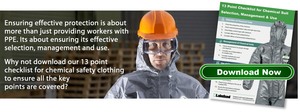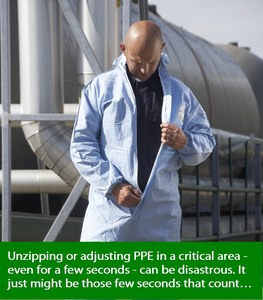
 |
Mark Sennett
Managing Editor |
 |
Kelly Rose
Editor |
| Home> | PPE | >General PPE | >My grandfather, the Great War and modern PPE and safety practices |
My grandfather, the Great War and modern PPE and safety practices
08 March 2021
MARTIN LILL gives an insight into how his grandfather’s horrific experience in the Great War highlights a critical issue for modern users of PPE.

In the Great War my grandfather was a young soldier hunkered down in a trench somewhere in Northern France. As a result of a momentary dropping of his guard he suffered a life changing experience that provides an important lesson for modern managers of safety and PPE.
When I was a very small boy – and this is long ago enough that it was in the days when small boys habitually wore short trousers - my paternal grandfather told me a story about what happened to him in the First World War. It was a story that had an impact; it has stayed with me all these years, even though for family reasons I lost touch with that side of my lineage some thirty years ago, and despite the fact that at the time I did not (being but a small boy) appreciate its full implications.
For some reason the story popped into my head a few weeks ago, at which time not only did the full implications hit me, but I realised it is a classic example of a very important issue in the modern world of safety and PPE. The story was this…
Sitting in his trench one day he did something stupid that very nearly cost him his life. Just for a moment he took off his helmet. Not a major crime one might think. It was just for a few seconds. He might not have thought about it all… or he might well have thought to himself those dangerous words in the world of safety:
“It’ll be OK…”.
Unfortunately, it wasn’t. During those few seconds whilst his helmet was removed a stray shell struck a glancing blow to the back of his head. It literally removed a chunk of his skull.
When he told me this story he showed me the proof by letting me feel his head. Sure enough there was a perfectly round “hole” at the back of his skull. It was about 4 inches across and appeared as a “dent” where the bone was entirely absent, but the skin had grown back over it. You could feel the edge of the bone and inside, beneath the skin, the soft tissue of the brain. To a curious boy it was fascinating.
Yet thinking about it now, given this was the early 20th Century when medicine was far from what it is today, it is remarkable that he survived… but he did. The war was over for him however and following recovery he was sent home and proceeded to live a full and happy life, soon siring my father, and then eventually becoming a grandad to his grandson, me.
So what has this to do with modern PPE?
How many workers wearing a hard hat regularly remove it for a few moments on a hot day for a little relief? How many wearing a respiratory mask momentarily lift it for a few breaths of fresh air during the job? How many remove their goggles just for a second to wipe the sweat from their eyes? Or how many users of chemical suits pull down the zip a little to allow some air in?
Murphy’s law is not really a law at all but an adage that tells us that if something bad can happen it will. It doesn’t always apply of course. The worker on the building site will momentarily take off his hard hart ninety-nine times… then the hundredth time will be the precise moment a colleague on the scaffolding above accidentally drops a brick…
…or another worker will momentarily lift his breathing mask for a breath of fresh air many times without a problem… until the time when just at that moment a valve bursts and a jet of pressurised toxic gas is sprayed in his face…
… or of course, a soldier on the battlefield may often remove his helmet momentarily to scratch his head… until the time when it actually matters…
My grandfathers’ experience is a perfect example of an important and oft neglected rule in safety…never remove or adjust PPE in a way that might leave you exposed in a critical area – even for a few seconds. Because those few seconds might well be the ones that count.
For safety managers it is also an important lesson in how managing the use of PPE is just as important as selecting the right PPE; the fact is, the best PPE in the world can be next to useless if it is not worn or used properly… even for a few seconds…
And managing the use of PPE extends far beyond the issues of selection or of understanding hazards and safety standards. It enters the areas of managing people and how they behave, of ensuring effective training so people understand the hazard and its consequences, of the danger of risk tolerance and behavioural psychology… all can have an important influence on ensuring that once you have selected the correct PPE, the workers whom you are charged to protect will use it properly, consistently and at all critical times.
Which is why, as one of the world’s leading manufacturers of chemical protective clothing we have produced a thirteen point checklist covering the selection, management and use of PPE. Of course, some might say “unlucky thirteen!”. Perhaps so, but then protecting workers from life-threatening hazards is nothing to do with luck and everything to do with effective procedures and management… and having a checklist to ensure you cover all the angles.
You can read about part of this process – “How to Choose Effective Safety Equipment and Procedures” in our blog.
My grandad found out the hard way about the risk of thinking “It’ll be OK” and a momentary lapse of care… and just about got away with it. Had that bullet been perhaps an inch lower it would almost certainly have killed him. A little higher and it would have missed, he would have survived and stayed in that dreadful war. Would he have survived more of that hell? Who knows?
But I owe my very existence in part to the precise trajectory of that bullet that hit just in a way that it didn’t kill him but injured him sufficiently for him to be sent home. A sobering thought.
- Hazmat suit donning and doffing
- Dress for success
- Can you assume you are safe in a chemical suit certified for Type 3, 4, 5 or 6 protection?
- How do you solve the problem of uncomfortable chemical suits?
- Safe-use times for chemical suits
- Understanding EU and US PPE Standards
- App determines safe exposure
- The way you assess how long you can use your chemical suit is changing! Find out how with Lakeland at A+A 19.
- Permasure app
- Suitably dressed?


























